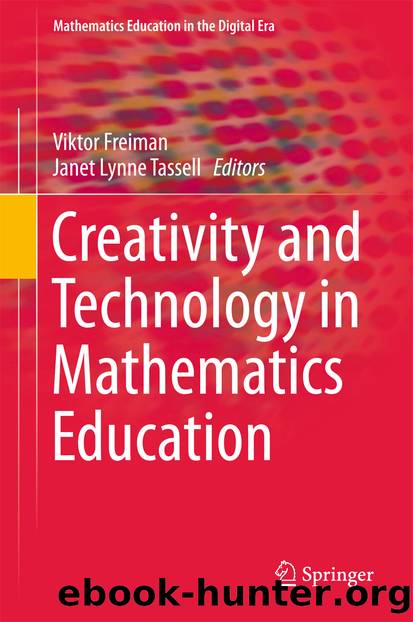Creativity and Technology in Mathematics Education by Unknown

Author:Unknown
Language: eng
Format: epub
ISBN: 9783319723815
Publisher: Springer International Publishing
11.3 Fostering Creative Spatial Learning Opportunities: Contributions from Technology
Acquiring early mathematical skills inherently relies on creative discovery as well as explicit instruction (e.g., Alfieri, Brooks, Aldrich, & Tenenbaum, 2011; Hirsh-Pasek, Berk, Singer, & Golinkoff, 2008). Considerable literature in early mathematics education supports the need for children to explore and mathematize key concepts through application to diverse novel contexts (e.g., Newcombe, 2010; Uttal, 2000). This would require mastery of spatial concepts embodied physically as in the real world and represented abstractly as in visual images and representations such as maps and models.
Physical manipulatives are static but concrete, thus multiple manipulatives might be necessary for a child to discover or realize key spatial concepts In addition, providing both prototypical and non-prototypical examples (Satlow & Newcombe, 1998) or creating model representations (Siegal & Schadler, 1977) may further understanding. For example, understanding the concept of a cylinder can involve exposure to multiple examples evident in children’s everyday lives (e.g., tinned goods, cookie jars) and also by having children manipulate various cylindrical shapes in block building, puzzle solving or other contexts. Virtual 2D manipulatives, however, afford learners an opportunity to dynamically manipulate objects on screen using screen tools such as swiping and touching. For example, given that the visual prototype of a triangle for young children between four and six years old is an isosceles triangle, identifying triangles (other than an isosceles triangle) is difficult for most young children (Aslan & Aktas-Arnas, 2007; Clarke, 2004; Clements, Swaminathan, Hannibal, & Sarama, 1999; Yin, 2003). However, software could make salient features of different triangles quickly apparent to young children by systematically resizing defining attributes such as aspect ratios of width and height as well as skewness (or lack of symmetry) as a child expands or shrinks the image of a triangle or series of triangles on screen. As such, an extensive and “manipulateable” representation of various types of triangles—isosceles, equilateral, right angled—could be made available through the use of technology . Such dynamic and non-static representations of multiple variations of triangles are not easily accomplished in single integrated presentations using physical manipulatives. Dynamic representations of spatial features and relationships in a virtual medium may, therefore, enhance children’s acquisition of abstract spatial concepts.
Abstract representation of spatial concepts underlies learners’ spatial thinking and reasoning. To make sense and to respond appropriately in our environment, we organize and process spatial information using two frames of reference—egocentric and exocentric (Klatzky, 1998; Shelton & Mcnamara, 2001). Spatial information in the environment in an egocentric or self-based frame of reference is processed and organized from an individual’s perspective, bearing or orientation such as the distance of an object from oneself. This frame of reference allows us, for example, to extend our arm to an appropriate length to pick up a mug on the table by judging the distance between oneself and the table. However, representation of spatial relations among objects in the environment varies accordingly to the individual’s bearing. In our mug example, the distance between oneself and the table would differ if one were to stand at the corner of the table versus the side of the table.
Download
This site does not store any files on its server. We only index and link to content provided by other sites. Please contact the content providers to delete copyright contents if any and email us, we'll remove relevant links or contents immediately.
Wonder by R.J. Palacio(8510)
Mastering Adobe Animate 2023 - Third Edition by Joseph Labrecque(3813)
Unlabel: Selling You Without Selling Out by Marc Ecko(3624)
Ogilvy on Advertising by David Ogilvy(3552)
Hidden Persuasion: 33 psychological influence techniques in advertising by Marc Andrews & Matthijs van Leeuwen & Rick van Baaren(3517)
Drawing Cutting Edge Anatomy by Christopher Hart(3484)
The Pixar Touch by David A. Price(3389)
POP by Steven Heller(3326)
The Code Book by Simon Singh(3136)
The Art of War Visualized by Jessica Hagy(2973)
Slugfest by Reed Tucker(2972)
The Curated Closet by Anuschka Rees(2940)
Rapid Viz: A New Method for the Rapid Visualization of Ideas by Kurt Hanks & Larry Belliston(2869)
Stacked Decks by The Rotenberg Collection(2842)
365 Days of Wonder by R.J. Palacio(2786)
The Wardrobe Wakeup by Lois Joy Johnson(2754)
Keep Going by Austin Kleon(2726)
Tattoo Art by Doralba Picerno(2623)
Tell Me More by Kelly Corrigan(2620)
